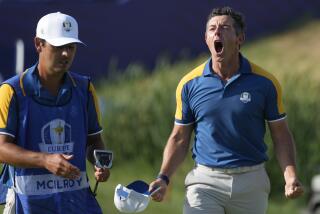1997 Ryder Cup Primer
- Share via
WHAT: The Ryder Cup is played every two years between teams of 12 U.S. players and 12 European players. Ten players on each team qualify by accumulating points in a designated format; two players on each team are selected by that team’s captain.
* SITE: Valderrama Golf Club in Sotogrande, Spain, is the first course outside Great Britain or the United States to host the event. “It’s the best-conditioned course in the universe,” Ernie Els said. “The best greens you’ll ever see are at Valderrama.”
* WHEN: Friday through Sunday. Eight two-man team matches will be held on Friday, eight more on Saturday and 12 singles matches will be held Sunday.
* SCORING: There are 28 matches over three days, each match worth one point. The team finishing with at least 14 1/2 points is the winner. If the teams are tied after the final match Sunday, the team that holds the Cup, in this case Europe, retains it.
* MATCH PLAY: Competition is match play, which means matches are determined by the number of holes won, not by overall strokes. A match ends when a player (or two-man team) has a lead of more holes than remain to be played: For example, Player A is ahead by three holes after playing the 16th hole. Since only two holes remain, Player A wins, 3 and 2, and earns a point for his side. If a match is tied after 18 holes, each side receives half a point.
* FORMAT: Three formats are used: four-ball, foursomes and individual match play. On Friday, there are four four-ball matches in the morning and four foursome matches in the afternoon. That format is repeated Saturday. On Sunday, there will be 12 individual matches.
* Four-ball: Each player on the two-man teams plays his own ball, the lower of the two scores counting against the lower score on the opposing team. Also called better-ball.
* Foursomes: The players on each team alternate shots until the ball is holed. One player hits the tee shots on even-numbered holes, the other on odd-numbered holes.
* Individuals: One-on-one match play.
* PAIRINGS: The captains--Tom Kite from the U.S. and Seve Ballesteros from Europe--determine which players will be paired for their own sides. Each captain writes down the two-man teams he has selected in starting order for each session and puts that list in an envelope. The envelopes are then opened and the matches are set. For individual play, the captains again list their players in order of play.
* STRATEGY: The lineups are where the captains use their strategy, pairing players they believe will complement each other, trying to guess what players the opposing captain will team together and what order he might play them. Conventional wisdom sometimes dictates that in four-ball, players of different strengths work well together: a gambler might be best matched up with a consistent, less aggressive player. In foursomes, the general feeling is that players with similar strengths can help each other the most, since they can relate their own games to their partners’. And in individual play, better players who can be expected to stand up under additional pressure often are scheduled to tee off late. But there are always exceptions. In 1983, European captain Tony Jacklin decided to play his dominant player, Seve Ballesteros, first, a move that caught U.S. captain Jack Nicklaus by surprise.
“I can still see the look of shock and horror on Jack’s face after he and I exchanged envelopes,” Jacklin said. The U.S. managed to win, 14 1/2-13 1/2, but Europe had signaled that year that it would be a force in subsequent years.
FUTURE SITES
1999
The Country Club
Brookline, Mass.
*
2001
The Belfry
Sutton Coldfield, England
*
2003
United States
Course to be announced
*
2005
Ireland
Course to be announced
TV Coverage
* Friday: 8 a.m. to 6 p.m. (delayed), USA.
* Saturday: 11 a.m. to 5 p.m. (delayed), Channel 4.
* Sunday: 5 a.m. to 9:30 a.m. (live), Channel 4.
More to Read
Go beyond the scoreboard
Get the latest on L.A.'s teams in the daily Sports Report newsletter.
You may occasionally receive promotional content from the Los Angeles Times.










